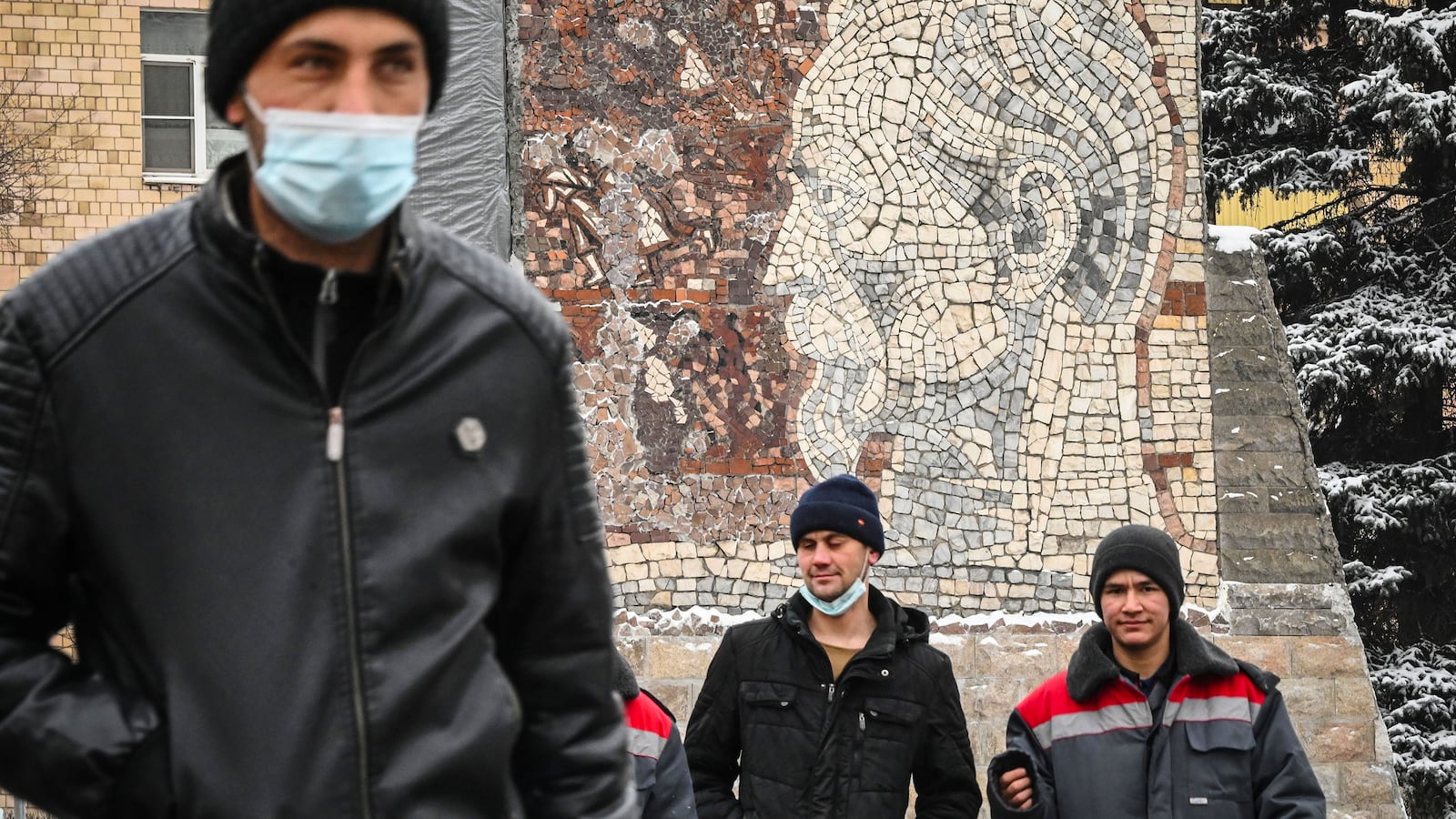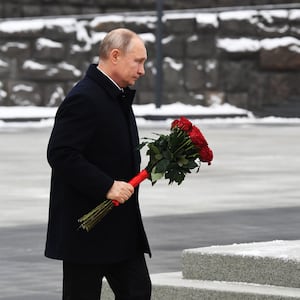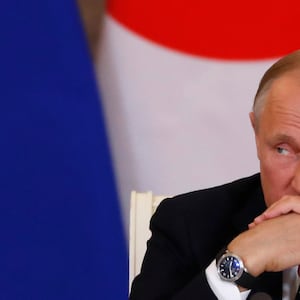MOSCOW—Russia’s state atomic energy agency has seen fit to mount two full-sized figures of Lavrenty Beria, one of the most ghoulish villains of the Great Purge, in its latest exhibition. The bizarre move to resurrect the hate figure has shocked Moscow, where every post-Soviet child knows Beria as one of the most feared hangmen of the Stalin era.
Officials at Rosatom, the nuclear agency, insist that without Beria, the USSR would not have built its arsenal of atomic bombs. But then, Beria is not the only ghost of the Stalin era finding a place of honor in the Russian capital today. As new repressions tarnish modern Russian politics, Russian historians and educators are urging the public to pay attention to the glorification of Soviet tyrants and criminals, an issue that came into focus this week.
Ever since a former KGB agent, Vladimir Putin, rose to the presidency, Russian authorities have been polishing rusty old symbols of the Soviet terror. Moscow toppled the statue of Felix Dzerzhinsky in 1991, but by 2005 the dark bust of Iron Felix returned to the police headquarters on Petrovka avenue. Two decades ago nobody could imagine a Stalin statue in the Russian capital. By 2017 a bust of Stalin emerged in the newly created Alley of Leaders, just a few blocks away from the Kremlin, to the great joy of many Stalinist groups. “Now we see authorities taking a step towards the rehabilitation of Beria, who was up to his ears in his victims’ blood—he personally ordered the deportations of Soviet peoples to Central Asia and gave secret orders to execute prisoners,” Alexander Cherkasov, chairman of the Memorial human rights center, told The Daily Beast.
The revival of Beria coincided with news of Russian opposition leader Alexei Navalny being arrested and imprisoned in Matrosskaya Tishina, a notorious prison, where another famous Kremlin critic, lawyer Sergei Magnitsky, died in mysterious circumstances in 2009. One more Putin opponent, Russia’s richest man Mikhail Khodorkovsky, spent four years in that prison. “The conditions are not great there, they can [kill] you any moment,” Khodorkovsky wrote in his post on Instagram.
Navalny and his supporters were shocked to see a portrait of Henrich Yagoda, Stalin’s director of the NKVD, a predecessor of the KGB, on the wall, looming over Navalny’s improvised court hearing at an ordinary police station. “That was like a message from Putin on that wall—the executions begin now,” Pussy Riot leader Maria Alyokhina told The Daily Beast during the rally against Navalny’s arrest.
Pussy Riot activists go from trial to trial to support political prisoners; they also promote the MediaZona publication which covers court cases in Russia. “Only public support can make the difference and stop the authorities from isolating activists, silencing the opposition,” Alyokhina said. She knows from personal experience how a voice can be erased from the public debate—she spent nearly two years in jail for performing one anti-Putin song at a church in Moscow.
Even for Russians outside opposition circles, the framed picture of Yagoda at Navalny’s trial went too far. Tamara Eidelman, a teacher, expressed outrage in an editorial, titled “Yagoda? Isn’t this too much?” published on the website of Echo of Moscow. Although “Beria was the most famous of Stalin’s executors,” Yagoda managed the special services for a decade, starting from 1934, she noted. “Those were the years known for fighting the opposition, for Trotsky’s exile… creation of the Gulag, arrests, executions, purges,” Eidelman wrote. He was executed in 1938.
By way of contrast, the granddaughter of the former Soviet leader Nikita Khrushchev looked all over Russia for a portrait or statue of the leader responsible for the “De-Stalinization” of the Soviet Union. “Yagoda portraits are available everywhere while Khrushev is uniformly omitted,” she said, telling the Daily Beast that her grandfather was blamed for executing Stalin’s hangmen. “I went into a total shock in November when at a tourist store I saw a statuette of Yagoda and everyone else literally, from Catherine the Great to to Brezhnev and Chernenko. I asked, ‘Where is Khrushchev, if even Yagoda is there?’ And was told, that the KGB is very popular again, that nobody wants Khrushev, when there is Stalin and Putin on sale.”
Killers like Yagoda and Beria were not just following orders. Rivalries and petty jealousies also played a role in their murderous sprees. In the book Lavrenty Beria, A Bloody Pragmatist, the murder of Marshal Grigory Kulik’s wife, Kira Kulik-Simonich is described. Apparently Stalin was attracted to the wife of his friend, but she turned him down. So Beria ordered her arrest and execution to cover up the shame for his leader.
Beria, who was Stalin’s minister of interior affairs among other things, was executed in 1953 for his crimes. “Yes, I admit my participation in mass repressions,” he told state investigators. “But I ask neither to qualify this as the crimes of counter-revolution, nor as treason against the Motherland.”
Beria ran the secret police for seven years, then managed Soviet atomic projects for several years. “Beria should be remembered for his crimes, for ordering mass deportations of peoples from the Northern Caucasus, executions of Polish prisoners. He was a mini-Stalin in the Caucasus, gave orders to beat people before executions,” said Nikita Petrov, a historian and archive researcher at the Memorial center.
The Memorial center was founded in 1987 in order to preserve the memory of victims of Soviet political repression. Hundreds of activists joined the organization over the years to research Soviet archives, help relatives find graves of their family members, and defend the human rights of modern political dissidents. Russian authorities condemned the group as “a foreign agency” in 2016. Activists of the human rights center have faced attacks, beatings, murder and arson.
Last week, men from Memorial’s Moscow office dressed in identical velvet scarves and hats protested against a Stalin-themed kebab restaurant opening in Moscow.
The Memorial chairmen Cherkasov told The Daily Beast that this was more than a marketing gimmick by the owners. “They are Stalinists, activists of a new Kremlin loyal opposition group led by Zakhar Prilepin, a novelist and veteran of the war in Donbas,” he said. “Prilepin is also a longtime activist of the Nationalist-Bolshevik movement, famous for their controversial slogan: ‘Stalin, Beria, Gulag—that is how we are going to put the end to Perestroika!’”
A few years ago Putin opened a monument called the Wall of Grief to more than 750,000 Soviet citizens who were executed and millions more who were deported. “This terrible past must not be erased from our national memory and cannot be justified by anything,” Putin said.
Clearly the dark past has not been erased. Almost a century after Stalin’s repressions, Russians complain that the atmosphere of Stalin’s hangmen seems to be returning. Navalny’s wife, Yulia, photographed a vehicle outside of her apartment building on Tuesday. “They persecute me, as a wife of the ‘people’s enemy;’ 1937 has returned, and we didn’t even notice,” she wrote on Instagram—more than 200,000 people liked her post.
The public response to Putin’s crackdown is becoming more pronounced. More than 20 million people watched Navalny’s video investigating a lavish palace which has been built on the Black Sea for Putin at an estimated cost of a billion dollars. Construction of the giant palace started years ago, but the Kremlin has denied any connection to the Russian president.
Over the past year, public trust in Navalny has more than doubled from just 9 percent to 20 percent, according to Levada Center’s social polls. Hundreds of Navalny’s supporters gathered in Vnukovo airport on Sunday to welcome their leader back to Russia, after almost five months of recovering from what German doctors believed was a potentially fatal Novichok attack. Russians have also joined rallies this week, in spite of bitter weather and a high risk of ending up behind bars.
On Sunday, a young politician, Valery Kostenok, and his friends realized that Navalny’s plane was not landing in Vnukovo, so they grabbed their car and rushed to Sheremetyevo airport to catch up with Navalny. “Police detained us, when we were coming out of the restroom in the airport, they already knew my vehicle—I guess video cameras had been watching us,” the 21-year-old told The Daily Beast. Kostenok’s girlfriend is worried about his safety, but he says one month in jail in 2019 changed him: “I am not afraid of anything, my team and I are determined that grassroots democracy is possible in Russia. History seems to repeat itself in Russia; but it did not end well for Stalin and his men. Our job is not to allow that to happen again, make Russia free and democratic—we are this country’s future.”








